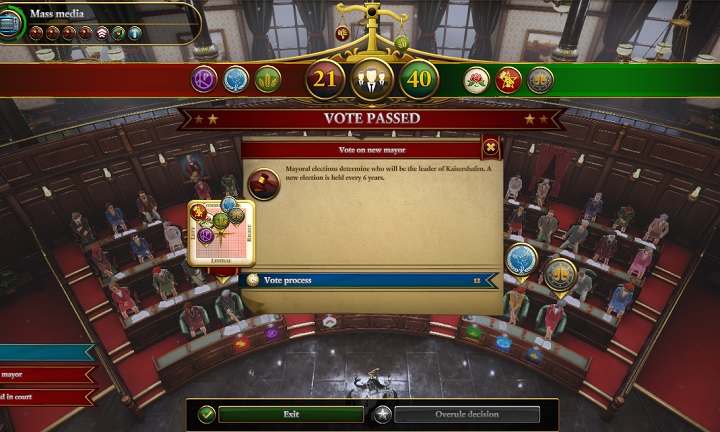Voting | Politics
In the following chapter you will find a collection of valuable information about the voting process in the Urban Empire production. Individual stages have been described in their own specific sections.
- 1. Introducing a motion and initial support
- 2. Exerting influence on party members
- 3. Final attempts of swaying the vote
- 4.Counting votes and overruling decisions
1. Introducing a motion and initial support

After submitting a project of any resolution, it is time for all City Council members to establish their position on the issue of said resolution. As you can see in the picture above, right after the project is submitted, you will receive an approximation of how the vote would turn out, if it were carried out on the same day.
The initial station is dependent on the party’s political compass, and also on whether it is you or another party that is submitting the resolution. In this aspect Political goodwill is also important. If you are putting forward your own project, and the goodwill modifier is positive, you can expect that the majority of members will be keen to enact your proposal. Initial support can also be generated by the will to fulfill some of the six basic needs of the citizens. In this area, changing the support modifier cannot be done by means other than fulfilling a specific need of the citizenry, however, the time between submitting the resolution and the vote is usually so short, that you will not be able to act in this area.
Depending on the initial station the number of Council members, who are certain to approve the project and who are certain to oppose it, is determined. The remaining votes can be distributed in various positions on the spectrum, but if the scale indicated in the picture above is in your favour, then you need not worry about the result of the vote.
2. Exerting influence on party members
The whole fun begins when the initial station of the City Council is not in favour of you proposal. In such a situation you can use one of the interface buttons, to influence the decisions made by representatives of individual parties. For each of the parties you will see the current Goodwill modifier. Depending on the value of this modifier, your actions will be more or less effective. Exerting influence will be discussed in detail in another chapter, but it is worth mentioning, that you have a choice between: a request, a demand or a threat.
As you can see, in the first tally it does not appear that your motion will be accepted, and you should immediately begin to act, as mentioned before. Each month the Council will debate the motion, which means, that you will be able to act in order to convince the Council to see things your way. You can do this as long, as the members of individual parties will be willing to listen to you, however, you must know that trying to exert influence (whether successfully or not) lowers the Goodwill modifier, the value of which can drop to a level, that will result in the members ignoring your station and simply laughing you away.
Be mindful of messages, which can appear in the upper left corner, right under the research progress bar. They concern the result of debates on a given project, which took place without your interference. The results of such happenings are extremely crucial, when they concern the party that has the overwhelming majority in the House. It may turn out, that your efforts are meaningless after one internal party discussion, and the party will still refuse to support the motion, and additionally will not forget for a long time that you tried to influence its decision.
3. Final attempts of swaying the vote
When it is finally time to vote, the flow of time in the game is paused, and you have to switch to the City Council view. You can still influence the result of the vote, as long as you have not alienated all of the parties, but the impact of your speech will not be as substantial as in the first months after the project was submitted. In the end, if the project is important, than you may try it, and if you fail than you will repent on another occasion.
4.Counting votes and overruling decisions

After all of the options to manipulate the result are spent, it is time to vote. The votes are tallied from individual members of the Council, and next to the stations you will find the symbols of the parties which decided to vote either for or against the motion, with the majority of their votes. After the votes are counted, the results are published. Remember, that the motion is approved or overruled by a simple majority of votes, so even a single vote can dictate the fate of the resolution.
If you are popular enough and have generated enough prestige points, you may reject an unfavourable Council decision and “push” the motion through, without the Council’s approval. It is important to point out, that such an action is rarely possible, and requires a lot of prestige points, so you should be certain that the motion is worth spending your carefully collected points on.
If you do not bypass the Council’s decision, and it is unfavourable, you can try submitting the same project again, or you can modify it a bit. It is important to keep in mind, that trying to exert influence upon Council members will put you in a bad spotlight for a long while, so you should expect any motions you make to go straight to the garbage can.
You are not permitted to copy any image, text or info from this page. This site is not associated with and/or endorsed by the Kalypso Media or Fragment Production. All logos and images are copyrighted by their respective owners.
Copyright © 2000 - 2025 Webedia Polska SA for gamepressure.com, unofficial game guides, walkthroughs, secrets, game tips, maps & strategies for top games.
